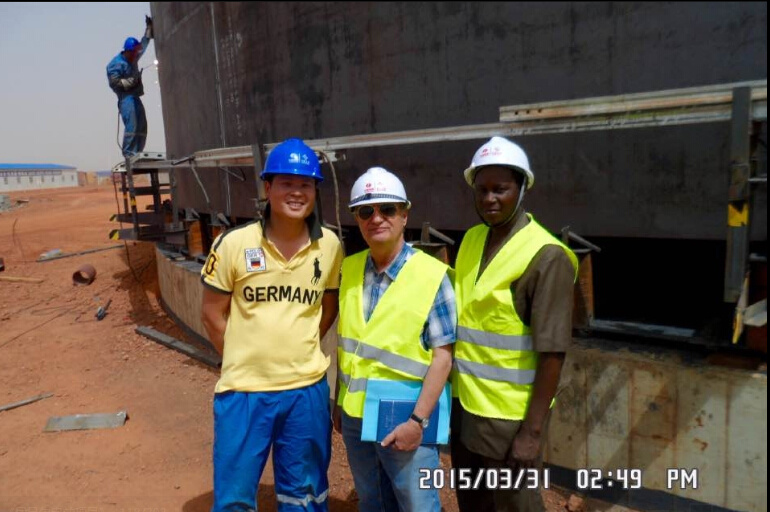API650 oil tank design and installation
Categories:
Hong Kong Qingshan Power Plant 7000m undertaken by our company ³ Wave pattern painting on the outer wall of process water tank is completed! Recently, our company undertook 7000 m of Hong Kong Qingshan Power Plant ³ The external wall of process water tank is painted with wavy pattern. The completion of this work also indicates that Hong Kong Qingshan Power Plant is 7000m ³ The process water tank construction and installation project has been formally completed and will be put into formal production.
Most regions and countries in Europe, America and the world adopt American standards such as API650, API620, and API12d to design, build, and install oil tanks and storage tanks. API is an API standard series. API is the American Petroleum Institute. Founded in 1919, API is the first national commercial association in the United States. It is one of the earliest and most successful chambers of commerce in the world to formulate standards. It is an important task of API, It is responsible for the standardization of equipment used in the oil and gas industry to ensure the safety,
Details
Design, installation and application of API650, API620 and API12d large oil tanks
Most regions and countries in Europe, America and the world adopt American standards such as API650, API620, and API12d to design, build, and install oil tanks and storage tanks. API is an API standard series. API is the American Petroleum Institute. Founded in 1919, API is the first national commercial association in the United States. It is one of the earliest and most successful chambers of commerce in the world to formulate standards. It is an important task of API, It is responsible for the standardization of equipment used in the oil and gas industry to ensure the safety, reliability and interchangeability of equipment used in the industry. The development of harmonized standards is one of the earliest and most successful projects of API. API standards mainly specify equipment performance, and sometimes also include design and process specifications. The fields of standard development include oil production, refining, measurement, transportation, sales, safety and fire protection, environmental regulations, etc. Its information technology standards include oil and gas industry, communication and information technology applications, etc.
The application of API650 is as described by American Petroleum Institute: the fabrication and installation of our ground welded steel tanks are generally applied in industry; In general, American industrial field installed tanks are built in accordance with API 650, API620 and API12d standards. Welded steel tanks are designed, manufactured and installed on the ground in accordance with the classification of API standard system. All three API standards use field fabricated and installed tanks. The following is an overview of tank design and construction in accordance with American standards:
1. API650 Tanks tank construction standard:
The most widely used standard for tank construction and procurement in the world is API 650. The Chinese translation name is API650 Steel Welded Oil Tank. API 650 tanks are used for commonly used oil products, gasoline, diesel, chemicals and production water storage. Tanks built to these standards are found in refineries, docks, pipelines, and production facilities throughout the United States. The detailed standard API 650 specifies the design, processing, welding, inspection and installation procedures for storage tanks.
2. API620 Tanks tank construction standard:
The Chinese translation name of the API620 design standard is API620 Design and Construction of Large Low Pressure Storage Tanks, which is a design and construction specification for large welded steel and low pressure storage tanks. API 620 storage tank operates at 250 ° F or less and the operating pressure exceeds 2 pounds ⁄ ½ stay ² Less than 15 pounds ⁄ at ² Count.
3. API12d Tanks tank construction standard:
The Chinese translation name of API12d design standard is API12d Field Welded Oil Storage Tank, which is one of the three most famous standards used for field welding of liquid or oil storage tanks. This standard is for on-site installation of storage tanks, API12d reserved tank size and storage capacity, as well as accessories and testing requirements. By creating a fixed size and required API12d, the need for further engineering has been eliminated, effectively reducing the cost of storage tanks.
4. API650 application promotion:
Wuhan Zhongheng Petrochemical Environmental Protection Equipment Technology Co., Ltd. has been engaged in the design, construction and installation of foreign API650 standard storage tanks for a long time. It has the international qualification of ASME welding technology, the design capacity of API650 oil tanks and API650 storage tanks, the design and manufacturing license of pressure vessels, the installation license of GC pressure pipes, the general contracting qualification of petrochemical equipment and pipelines, the safety production license, and the international trade import and export certificate, The design and construction performance of API650 storage tank has spread all over the world, including the storage tank farm of Haila Power Plant in East Timor, the storage tank farm of Comodo Power Plant in East Timor, and the oil tank farm of South East Timor Power Plant; South America Ecuador oil tank and water tank, Venezuela large heavy oil tank farm (the maximum volume of a single tank is 30000 m3); Overall construction and design of oil storage tank, demineralized water tank and water tank of Middle East Turkey Power Plant Phase I and Phase II; Design and construction of the Armenian power station in Niger, Africa; Cameroon, Rwanda, Angola, South Bangladesh, Papua New Guinea and other product oil tanks are exported to many countries around the world.
5. (Picture) The working site of API650 heavy oil storage tank of the power plant in Niamey, Niger, Africa designed and built by our company under the supervision of German experts in 2015:

Code for design and installation of large vertical oil tanks in China
1、 Executive standard:
1. Domestic design standard: GB50341-2003 Code for Design of Vertical Cylindrical Steel Welded Oil Tanks
2. Domestic construction standard: Code for Construction and Acceptance of Vertical Cylindrical Steel Welded Oil Tanks (GB 50128-2005)
2、 Design specification:
1. The codes used for the design of large oil tanks are mainly API 650, JIS B8501, British Industrial Standard BS2654 and Chinese National Standard GB50341 from a worldwide perspective. The formulas used in each code are derived from the formula for calculating the circumferential stress in the membrane theory. Combined with the stress characteristics of oil tanks, the allowable stress, weld joint coefficient and additional wall thickness become a complete wall thickness calculation formula, Each specification determines its own allowable stress and weld coefficient according to the performance characteristics of materials and construction technology level of its own country. Therefore, oil tanks of the same volume are calculated according to different specifications, and the calculation results of tank wall thickness sometimes vary greatly.
2. According to the performance characteristics of domestic materials and the allowable stress and weld joint coefficient specified by the overall level of domestic construction enterprises, the Chinese national standard GB50341-2003 is more in line with the national conditions. This code is basically adopted in the design of oil tanks in our country.
3、 Construction specifications:
1. Construction method: the construction of ordinary vertical storage tank basically adopts the chain inversion method: construction preparation → material inspection → blanking → processing → inspection → welding of tank bottom middle plate → bow edge plate of tank bottom → center column Erection of umbrella frame → assembly and welding of top ring → assembly and welding of wrapped angle steel → assembly of temporary vault support → guide chain lifting device → assembly and welding of vault → assembly and welding of lower ring → jacking of top ring wall plate → circumferential seam welding → assembly and welding of each circumferential seam → assembly and welding of bottom ring bottom plate corner seam → bottom plate edge plate → inspection → accessory installation → vacuum test → overall test → settlement observation → handover.
2. Tank body prefabrication: three arc templates: one template for checking the curvature of the vault, with chord length not less than 2m; Check one inner arc sample plate with chord length not less than 1m for deformation of vertical weld corner; Check one outer arc sample plate for vertical weld deformation, and its chord length shall not be less than 1m.
3. Tank body assembly: according to the tank installation sequence, the lower surface of the bottom plate shall be protected against corrosion before installation. Before laying the base plate, the vertical and horizontal cross center lines shall be drawn on the surface on the basis of qualified acceptance. When the center line deviation marked by civil engineering is large (but within the allowable range), it shall be adjusted to the minimum.
4. Tank welding and weld inspection: the welding process assessment of butt joints, T-shaped fillet welds and tubesheet shall be carried out according to JB4708-92 Welding Process Assessment of Steel Pressure Vessels, and the on-site welding process instructions shall be prepared. The radiographic inspection of tank welds shall be carried out according to GB3323-87 Radiography and Quality Grading of Butt Joints of Fusion Welding of Steel.
4、 Test method:
1. Tank body test: vacuum leak test for the bottom plate. The vacuum method shall be used to test the leak of all the bottom plate welds. The vacuum degree shall not be less than 53Kpa, and the penetrant flaw detection method shall be used for reinspection.
2. Water filling test of tank body: floating plate lifting test, foundation settlement observation. Then, temporarily close all the openings on the upper part, open the transparent holes on the tank top, and fill the tank with water. The test water shall be fresh water, the water temperature shall not be lower than 5 ℃, and the pressure shall be maintained for 48 hours.
3. Tightness test, strength test and stability test of the tank wall and top: when filling the tank with water, when the water level is higher than 1m, close the transparent hole and foam vent on the tank top, continue to fill the tank with water, and set a temporary pressure gauge on the tank top to observe the pressure reading. The pressure stabilization test shall be carried out after the water filling test. When the water filling reaches the maximum operating liquid level, all openings shall be closed, and the drainage shall be carried out slowly. The negative pressure in the tank shall be generated, and the negative pressure reading
Keyword:
Floating roof oil tank
General contracting of petrochemical construction
General contracting of construction engineering
General contracting of electromechanical engineering construction
General contracting of penstock construction
Inquiry
Contact
Headquarter address: Floor 8, Shui'an International Office Building, Sanjiao Road, Heping Avenue, Wuchang District, Wuhan, Hubei Province
Factory address: Shuangliu Gulong Economic Development Zone, Yangluo District, Wuhan
Follow us


Quick navigation

